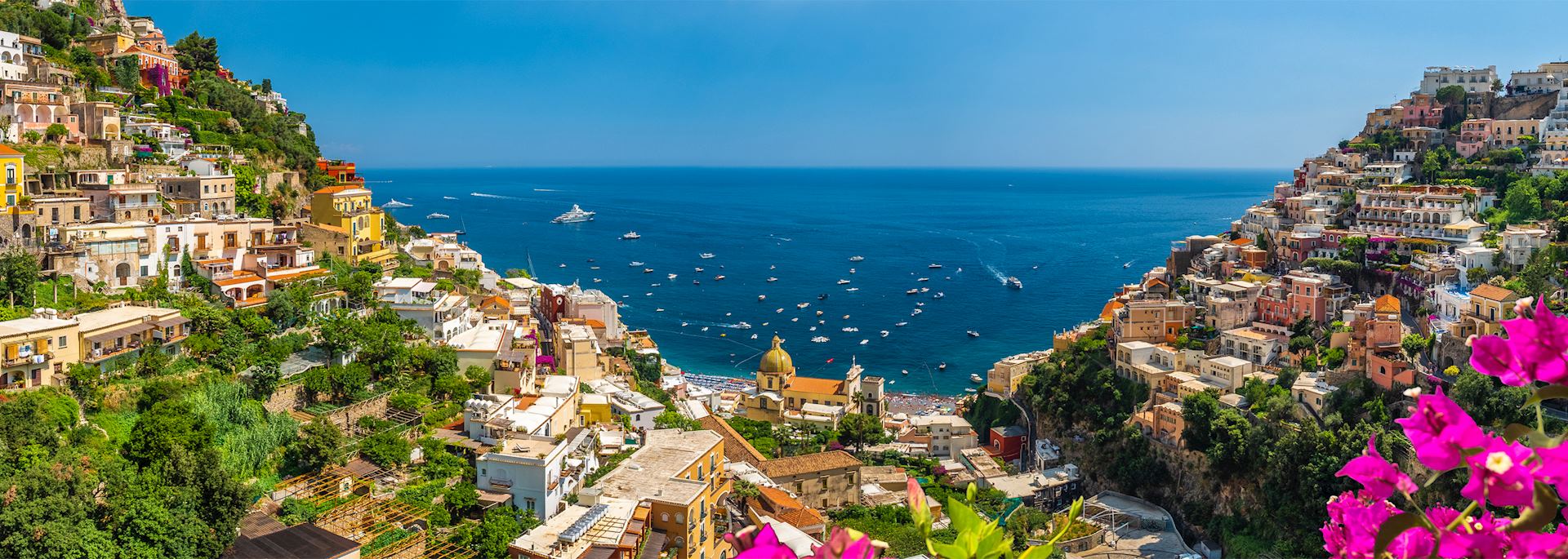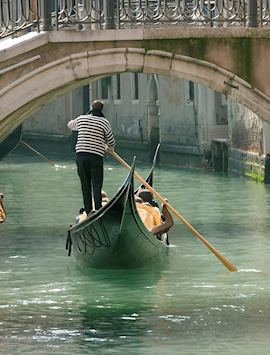By Italy specialist Caroline
Roman emperors came to pass their twilight years here. For writers, artists and composers, it acted as a muse. Europe and America’s social elite visited in droves throughout the 1950s and 1960s, seeking ‘la dolce vita’. Beyond this reputation as a pleasure ground, southwest Italy’s Amalfi Coast is all about the landscapes.
It’s a place of forested mountains and hills of lemon groves. Along the coast, villages of white and pastel matchbox houses are stacked up the cliff sides that plunge almost vertically into a cerulean sea.
If you’ve spent time energetically exploring other regions of Italy, the Amalfi Coast and the nearby island of Capri are places to relax. Spending time here is mostly about drinking in the views — either from a car, a boat, or on a hiking trail.
What to do on the Amalfi Coast: my selected highlights
Exploring the Amalfi Coast by car

In Sorrento, a resort town on the other side of the peninsula from the Amalfi Coast, you’ll be collected by your private driver and guide. Then you’ll pull onto the coastal road, zigzagging around the steep limestone cliffs and gullies that make up this rugged coastline.
Meanwhile, your guide will bring to life the history of this part of Italy — back to when only mule tracks linked the isolated villages along the Amalfi Coast.
Being a passenger leaves you free to focus on the views, rippling mountain ridges on your left and the Gulf of Salerno on your right. Villages and other sharply raked settlements emerge from around corners, and clumps of bougainvillea (a thorny bush or tree with bright blooms that thrives in the Amalfi Coast’s Mediterranean climate) dot the cliff sides.
Your first stop is Positano. This one-time fishing village was a ‘dream place’ for the writer John Steinbeck. Its buildings spill down the rock face, culminating in a small, chic seafront and beach. You can wander up and down the stepped, pedestrian-only streets, pop into the Byzantine-influenced church, browse its boutique shops (linen clothing is a speciality) or simply stop for a coffee or limoncello, the Coast’s trademark liqueur. Your guide will show you the best shops, cafés, and gelaterias (ice-cream shops).

Next, you’ll visit Amalfi Town. Larger and busier than Positano, its tall, slim white houses slope down to the sea. I always make a point of visiting the cathedral, the Duomo di Sant’Andrea. It’s been modified over the centuries but its oriental elements hark back to when the town was its own maritime republic in the 11th century and traded regularly with the East. Best admired from the outside, your guide can help you unravel its hybrid of architectural styles.
Finally, you arrive in Ravello. It’s an elegant town of palazzos (palaces), winding streets opening onto intimate squares, and modest backstreet churches. High up the mountainside, it also has a rich artistic heritage. Wagner and Capote drew inspiration from the town, while the manicured gardens of the aristocratic Villa Rufolo host an annual opera festival.
For me, Ravello's the loveliest place on the coast. It’s quieter than Positano and Amalfi, and it has the best views. For the finest vista of all, I recommend ambling around the Renaissance gardens of the Villa Cimbrone.
British writer Virginia Woolf once enjoyed these fantastical, fairy-like grounds. Tunnels are draped in wisteria, and beds planted with imported English roses. The highlight is the Terrace of Infinity, a sweeping stone patio framed with pine and cypress trees and busts of Roman emperors. With the sea directly below you, you can retrace your route along the coast stretching all the way back to Positano.
Take part in limoncello tasting and sample lemony delicacies

The Amalfi Coast’s hillsides are furrowed with lemon groves that cascade down in terraces. They’re not in regimented rows, but wrap around houses and hamlets, oozing into every possible inch of space.
The oversized lemons grown here form the raw materials for limoncello, the coast’s signature liqueur. You can experience limoncello tastings in the countryside, surrounded by its main ingredient.
A guide will lead you in the direction of the local distillery. As you walk under the leafy boughs, you occasionally pass villages clinging to the slopes, and cross tiny, café-filled piazzas. I could see mountains in the distance and ruins of old churches on faraway summits, while the sea shimmered below. My guide explained the lemon varieties growing around us and the cultivation methods used.
After an hour’s gentle walking, we sat down at a café in a village square. The owner appeared with a tray of lemon-themed titbits for me to try: refreshing lemon water, marmalades and pastries. They were all delicious, but then came a test.
‘Show me how you eat a lemon,’ my guide said. I bit into it like an orange slice, reeling at the bitterness. Then he told me the secret: to eat the white pith as well as the pulp. And it wasn’t unpleasant at all: the pith counteracts the tartness of the fruit. When the next delicacies came — lemon slices sprinkled with coffee and cacao — I knew what to do.
The day ended at the local limoncello factory and distillery. After getting an insight to the whole process — from the workers who picked out the best lemons, to the machinery that removed the rind, I was eager to taste the liqueur. I can tell you that it’s best when it’s freshly made, and served ice cold.
Explore nearby Capri on a private boat tour

Juniper, olive, lentisk and lemon trees cloak this islet just off the coast of the Sorrentine Peninsula. Magenta bougainvillea festoons the houses. The marinas are often brimming with super yachts. Side streets lined with high-end boutiques open onto piazzettas (small squares). Roman emperors and European intellectuals alike would relax in loggias (a sort of terrace or veranda) overlooking the sea. Capri has always been sumptuous and sought after.
To experience the island without the crowds who bustle into its main town daily, you’ll need to take to the water. (You can also hike part of its perimeter — see further below.) On a private boat with your own captain, you can circumnavigate the island at your own pace.
You’ll skim by the rocky bases of towering, vertiginous cliffs and pass small inlets. The cliffs of Capri are mottled with the open mouths of sea caves. I suggest ignoring the most famous — the visitor-clogged Blue Grotto — and stopping to explore some of the smaller, lesser-known grottoes such as the Emerald Grotto, the Red Grotto, and the White Grotto. As with the Blue Grotto, sunlight pouring in through an underwater, unseen cavity lights up the seawater in the caves, making it seem luminous.

Sailing between the jagged stacks of the Faraglioni Rocks, you might stop for a swim in the calm waters nearby. After passing underneath a natural rock arch, you’ll moor at Capri’s Marina Grande. Your guide will then help you explore Capri Town, showing you some of the island’s more secluded spots for unobstructed views of the Sorrentine Peninsula and the Bay of Naples.
I like to visit the nearby Augustus Gardens. These botanical landscaped gardens built over a series of terraces feature a lookout point over the Faraglioni Rocks. You could also make the 45-minute walk from Capri Town to the sprawling ruins of Emperor Tiberius’ former pleasure dome, Villa Jovis. From its vantage point high on a cliff, it offers a panorama over the island. At the cliff edge, you can also peer down a dizzying 350 m (1,148 ft) to the sea below. Allegedly, this was where the emperor threw his enemies to their deaths.
Walking on the Amalfi Coast and Capri
Hike the Path of the Gods

This 6 km (4 mile) loose gravel path winds down from the wooded Lattari Mountains into Positano. Hugging the cliffside, the trail feels suspended above the sea. Apart from a few sections, it’s all downhill, and very doable for moderately fit hikers. It’s the most fulfilling hike on the Amalfi Coast, a one-day walk that delivers expansive views of the sea and coast along the whole path.
Bright yellow tufts of broom flank the trail. En route you’ll pass hillsides latticed with tiny vegetable patches, vineyards, and houses that seem so perilously perched and inaccessible that you wonder how they ever got there. On your left is the blue expanse of the Gulf of Salerno. Occasionally, as you round a headland, you’ll get a teasing glimpse of the coast extending all the way to Capri.
The trailhead lies inland in the small town of Bomerano in Agerola Province. It was here I met my guide. An experienced botanist, he pointed out the various herbs, grasses and the wild garlic bordering the trail.
After three or so hours of hiking, we arrived at a trattoria (restaurant) and small farm snuggled in the hills above Positano. Here I had — and this is no exaggeration — the best meal of my life, on an open-air terrace overlooking the sea.
I was met by the owner, who introduced me to his mother, the chef. After a tour of the vegetable gardens, they brought a selection of dishes made from local produce (there’s no menu) with local wine pairings and the ubiquitous limoncello. In true Italian style, the meal lasted hours.
Hike the Path of the Forts on Capri

This trail, also 6 km (4 miles) long, is a great alternative way of exploring Capri. Starting at the lighthouse in Anacapri, you’ll hike along Capri’s west coast, finishing with a descent to the Blue Grotto. Walking on a ledge twisting around the cliff sides, the highlights of this route are several well-preserved 12th-century forts marooned on lonely capes. Originally built to ward off attacks by the Saracens, they were also used to store ammunitions in World War II.
The path narrows severely in places, so sometimes you’re walking alongside stomach-churning drops. Don’t attempt this walk if you suffer from vertigo.
Places to combine with a visit to the Amalfi Coast
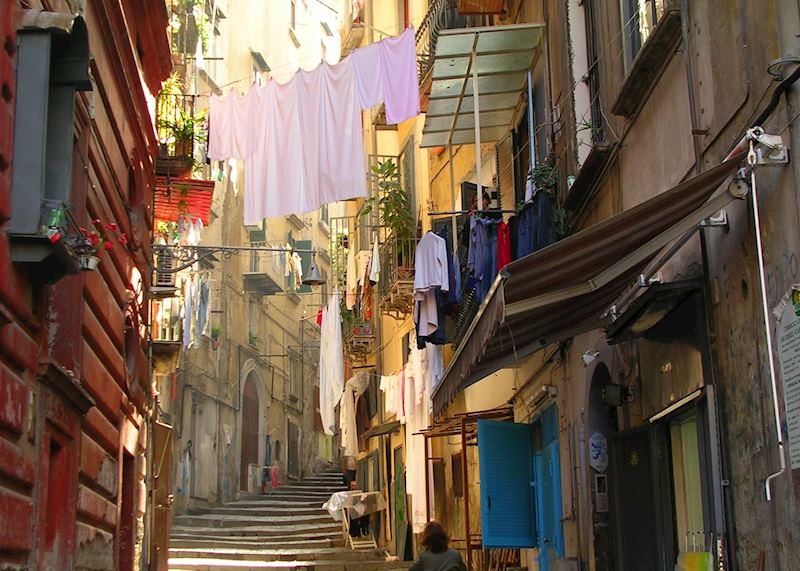
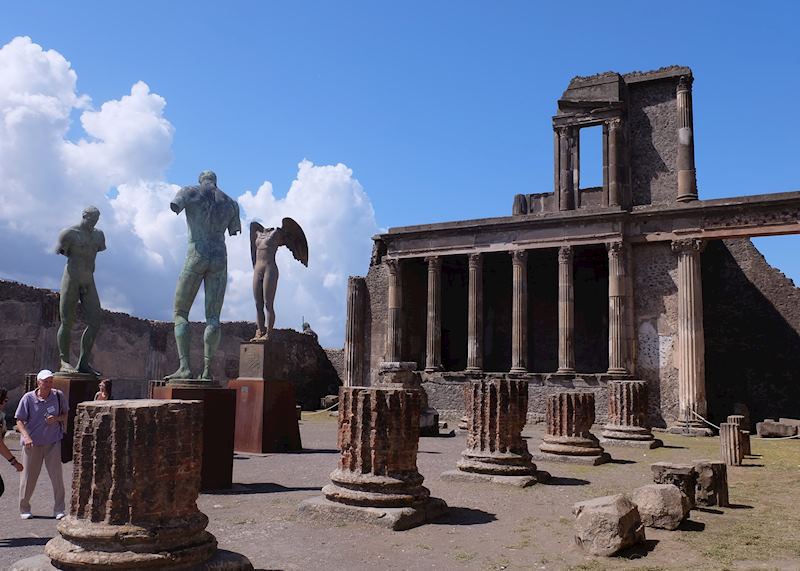
Naples can be a welcome contrast to the Amalfi Coast. On the surface, it’s grubbier, earthier and has none of the elegance of, say, Positano. It receives fewer visitors and feels very much like a locals’ town. As the home of pizza, its food — including pizza fritta, fried in seconds on street vendors’ stalls — is plentiful and celebrated.
I also highly recommend a visit to Pompeii. Easily accessible by an hour's car journey from the Amalfi Coast, aim to spend a full day there — it’s larger than anyone expects.
Located in the Bay of Naples, Ischia offers a down-to-earth counterpoint to Capri’s worldly glitz. Still largely undiscovered by international visitors, the volcanic island has been a popular destination for millennia with Italians, who come to take advantage of the thermal springs, thought to have healing powers.
Brilliantly evoked by novelist Elena Ferrante, the atmosphere here is languid and indulgent. You can laze on the sandy beaches, hike through leafy chestnut forests and, of course, soak in a steaming natural spring at one of the health spas here. We particularly recommend Negombo in San Montano Bay, which boasts 12 natural outdoor pools with different temperatures that range from brisk and refreshing to blood-warm and relaxing.
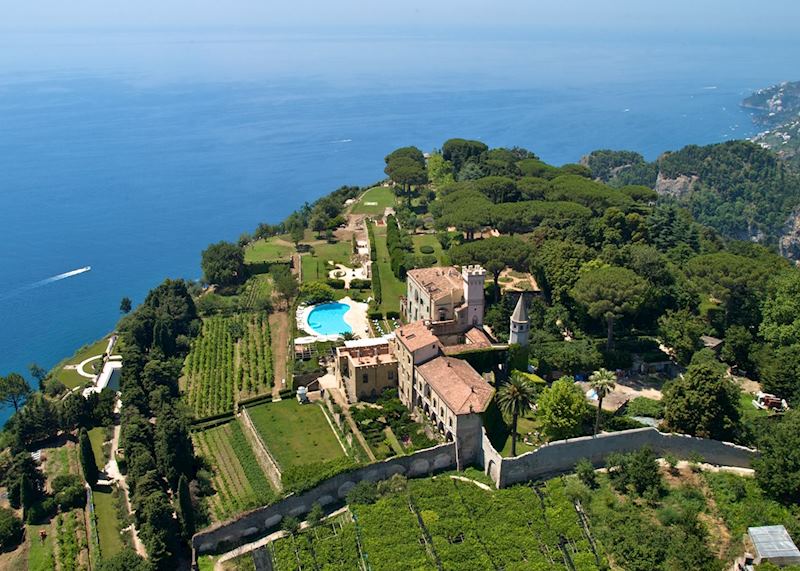

The 18-room Villa Cimbrone in Ravello captured my imagination. The whole property resembles a Romantic painting, with its courtyards, cloisters, frescoed rooms and majestic gardens. It also has a swimming pool with a view, and a Michelin-starred restaurant.
If you’re staying in Positano, try the boutique Villa Franca. Furnished in blue and white (the traditional shades of the Amalfi maritime republic), its playful yet tasteful decor uses modern artwork made from local coral. It has a great swimming pool and roof terrace. It’s also slightly removed from the main town, making it a quiet option.
Best time to visit the Amalfi Coast
Avoid the heat and crowds of the peak summer season and plan your trip for May, June or September.
Start planning your trip to the Amalfi Coast and Capri
Start thinking about your experience. These itineraries are simply suggestions for how you could enjoy some of the same experiences as our specialists. They're just for inspiration, because your trip will be created around your particular tastes.
View All Tours in The Amalfi Coast Region
